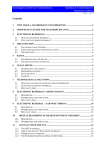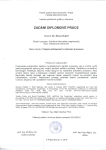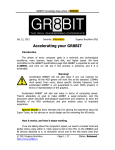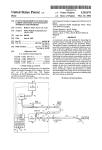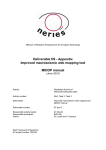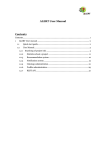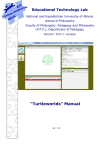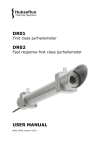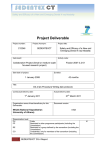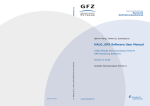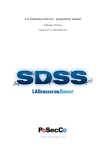Download User`s Manual
Transcript
ESPAS, the near-Earth space data infrastructure for eScience User’s Manual V2.1 (28th July ESPAS portal Release) Grant agreement no: 283676 Combination of Collaborative Project and Coordination and Support Actions ESPAS is co-funded by the European Commission under the 7th Framework Programme ESPAS User’s Manual Project Information Project acronym: ESPAS Project full title: Near-Earth Space Data Infrastructure for e-Science Project coordinator: Prof. Mike Hapgood Project web site(s): http://www.espas-fp7.eu/ Consortium Beneficiary number Beneficiary name Beneficiary short name Country Project entry month Project exit month 1 (Coordinator) SCIENCE AND TECHNOLOGY FACILITIES COUNCIL STFC United Kingdom 1 42 2 NATIONAL AND KAPODISTRIAN UNIVERSITY OF ATHENS NKUA Greece 1 42 3 EISCAT SCIENTIFIC ASSOCIATION EISCAT Sweden 1 42 4 DEUTSCHES ZENTRUM FUER LUFT - UND RAUMFAHRT EV DLR Germany 1 42 5 ISTITUTO NAZIONALE DI GEOFISICA E VULCANOLOGIA INGV Italy 1 42 6 WATERMANN JUERGEN FRIEDRICH WILHELM JFWCONSULT France 1 42 7 CENTRE NATIONAL DE LA RECHERCHE SCIENTIFIQUE CNRS-IPAG France 1 42 8 ATHENA RESEARCH AND INNOVATION CENTER IN INFORMATION ATHENA RC Greece 1 42 COMMUNICATION & KNOWLEDGE TECHNOLOGIES 9 OULUN YLIOPISTO uOulu Finland 1 42 10 UNIVERSITY COLLEGE LONDON UCL United Kingdom 1 42 11 MET OFFICE MO United Kingdom 1 42 12 THE UNIVERSITY OF BIRMINGHAM UB United Kingdom 1 42 13 INSTITUT D'AERONOMIE SPATIALE DE BELGIQUE IASB Belgium 1 42 14 CENTRUM BADAN KOSMICZNYCH POLSKIEJ AKADEMII NAUK SRC PAS Poland 1 42 15 DANMARKS TEKNISKE UNIVERSITET DTU Denmark 1 42 16 UNIVERSITETET I TROMSOE UIT Norway 1 42 17 ILMATIETEEN LAITOS IL Finland 1 42 18 UNIVERSITY OF LEICESTER ULEIC United Kingdom 1 42 19 Helmholtz-Zentrum Potsdam Deutsches GeoForschungsZentrum GFZ Germany 1 42 20 KONINKLIJKE STERRENWACHT VAN BELGIE ORB Belgium 1 42 21 DH CONSULTANCY BVBA DH Belgium 1 42 United States 1 42 CONSULTANCY 22 LOWELL DIGISONDE INTERNATIONAL LLC LDI 2 ESPAS User’s Manual Summary This document is the User’s Manual of ESPAS portal. It presents a detailed description of the ESPAS portal and its functionalities with examples and screen shots for the regular user. This manual is written and edited by: Anna Charisi, National Observatory of Athens Ioanna Tsagouri, National Observatory of Athens Anna Belehaki, National Observatory of Athens 3 ESPAS User’s Manual Contents Table of Contents Project Information ............................................................................................................................ 2 Summary............................................................................................................................................. 3 Contents.............................................................................................................................................. 4 1. ESPAS Portal ................................................................................................................................ 6 1.1 Home page .............................................................................................................................. 7 1.2 Register (user)......................................................................................................................... 8 1.3 Log in ...................................................................................................................................... 11 1.3.1 Forgot Password ........................................................................................................... 13 1.4 Sign Out ................................................................................................................................. 16 1.5 ESPAS Project ...................................................................................................................... 17 1.6 Contact Us ............................................................................................................................. 18 1.7 Search menu ......................................................................................................................... 20 1.7.1 Progressive search ....................................................................................................... 20 1.7.1.1 Time Period ............................................................................................................. 22 1.7.1.2 Assets ...................................................................................................................... 25 1.7.1.3 Observed Properties .............................................................................................. 30 1.7.1.4 Observation Collections ........................................................................................ 34 1.7.2 Spatial/temporal Search ............................................................................................... 38 1.7.2.1 Location ................................................................................................................... 38 1.7.3 Results/Location Results Page ................................................................................... 45 1.7.3.1 Share your results .................................................................................................. 51 1.8 Browse menu......................................................................................................................... 52 1.8.1 ESPAS Metadata .......................................................................................................... 52 1.8.2 ESPAS Space Physics Ontology ................................................................................ 57 1.8.3 ESPAS Supporting Vocabularies................................................................................ 61 1.9 ESPAS Policies menu.......................................................................................................... 64 1.10 Value Added Services menu ............................................................................................ 66 1.10.1 TEC Time Series Plotter ............................................................................................ 66 1.10.2 Plotting tool for OGC SWE data files ....................................................................... 68 1.11 Support menu...................................................................................................................... 70 1.11.1 About ESPAS............................................................................................................... 70 1.11.2 ESPAS Data Model..................................................................................................... 72 1.11.3 ESPAS Space Physics Ontology .............................................................................. 74 1.11.4 Glossary........................................................................................................................ 76 4 ESPAS User’s Manual 1.11.5 ESPAS User's Manual................................................................................................ 78 1.11.6 For Data Providers ...................................................................................................... 80 1.11.7 Data Providers' Status ................................................................................................ 82 1.11.8 Contact Us.................................................................................................................... 84 1.12 My Account menu ............................................................................................................... 86 1.12.1 My Personal Information ............................................................................................ 86 1.12.2 My Dataset File Downloads ....................................................................................... 88 1.12.3 My Data Values Downloads ...................................................................................... 93 1.12.4 My Location Searches .............................................................................................. 101 1.13 News ................................................................................................................................... 104 1.14 Events................................................................................................................................. 105 1.15 Partners.............................................................................................................................. 106 1.16 Data Providers .................................................................................................................. 107 2. Metadata Search: Examples ................................................................................................... 108 2.1 Progressive Search ............................................................................................................ 108 2.2 Spatial/temporal Search .................................................................................................... 114 3. Download of Data Files: Examples ........................................................................................ 118 4. Download of Data Values: Examples .................................................................................... 122 5 ESPAS User’s Manual 1. ESPAS Portal The ESPAS Portal has been developed in the framework of the ESPAS project (http://www.espas-fp7.eu/) and is available at: https://www.espas-fp7.eu/portal/index.html ESPAS is a data e-infrastructure facilitating access to observations and model predictions of the near-Earth space environment, a region extending from the Earth's atmosphere up to the outer radiation belts. Through the ESPAS portal the user has access to a large number of repositories with heterogeneous data from ground and space, in situ and remote sensors. The user can perform searches for observations using specific criteria (e.g. time, instrument) and download data files or data values. More precisely, the ESPAS portal provides the following services to the user: o Metadata search for observations that satisfy the following specific criteria: o Time period: the time period when the observations were acquired o Assets: the Instruments and Models that were used for the generation of the observations o Observed properties: the observed properties that were measured in the observations o Observation collections: the collections that the observations belong to o Location: the location of the platforms (ground-based observatories or satellites) on which the instruments are mounted and used for the generation of the observations The metadata search is open to all users with no registration required. o Data access: The result of a metadata search is a list of the observation collections (that contain the observations) that satisfy the query criteria. The user has access to the data through the options described below. Note that user registration and login to ESPAS portal is required for this service. o Download of data files provided by the ESPAS data providers. o Download of data values: A subset of the observed properties is available for download as extracted data values. After a data value download request, the user gets as a result a text file (in Ascii or XML format) that contains the values of the selected observed properties. o Plot of the data values: After a data value download request, the user can view or download the plot that presents the values of the selected observed properties. All the data and metadata available through the ESPAS portal are provided by the ESPAS Data Providers. The ESPAS Data Providers are special users of the ESPAS portal that have some added functionalities comparing to the simple user of ESPAS (e.g. register 6 ESPAS User’s Manual data). This manual presents a description of the ESPAS portal and its functionalities with examples and screen shots for the regular user. 1.1 Home page The home page of the ESPAS Portal is presented below and consists of the following areas: 1 2 5 4 3 6 7 8 1. Top right menu: provides the links for the “Login”/”Sign Out”, “Registration”, “ESPAS project” and “Contact” page. 2. Main menu: provides the links for the “Search”, “Browse”, “ESPAS Policies”, “Value Added Services”, “Support” and “My Account” pages (the “My Account” page is available after login). 3. An overview of the ESPAS services. 4. A link to the main “Search and Download” page. 5. A link to the “Manage Data Source” page (for the ESPAS Data Providers) or a link to Support → “For Data Providers” page (for the simple users). 6. News and announcements area. 7. A brief description of the ESPAS portal. 8. Bottom menu: provides links for the “News”, “Events”, “Partners” and “Data Providers” pages of ESPAS project website. 7 ESPAS User’s Manual 1.2 Register (user) In order to register to ESPAS portal, please follow the next steps: 1. Click the REGISTER link in the top right menu bar. 8 ESPAS User’s Manual 2. Provide the required information and click Register. Note that the fields marked with an asterisk (*) are mandatory. 3. A message is presented that confirms your registration to the ESPAS system and an email has been sent to your email address with instructions on how to activate your account. 4. Check your e-mail. An e-mail from the sender “[email protected]” has been sent that has a link in order to activate your account. Click on that link. 9 ESPAS User’s Manual 5. Your account has been activated and you are automatically logged in the ESPAS and redirected to the My Account → My Personal Info page, in case you want to edit your information. Note the “Hello, name” that is presented in the top right menu, that confirms your logged in status. 10 ESPAS User’s Manual 1.3 Log in For user login you need to follow the steps described below: 1. Click the LOG IN link in the top right menu bar. 2. Provide your credentials: email address and password, and click Login. 11 ESPAS User’s Manual 3. You are redirected to the “Home” page. Note the “Hello, name” that is presented in the top right menu, that confirms your logged in status. 12 ESPAS User’s Manual 1.3.1 Forgot Password 1. In case you have forgotten your password, then go to the “Home” page and click the LOG IN link in the top right menu bar. At the “Login” page, click the Forgot your password?link. 2. Provide your e-mail address and click Submit. 13 ESPAS User’s Manual 3. A message is presented that confirms your password reset request and an e-mail has been sent to you with instructions on how to reset your password. 4. Check your e-mail. An e-mail from the sender “[email protected]” has been sent that has a link in order to reset your password. Click on that link. 5. In the reset password page, give your new password twice in the appropriate fields and press Reset. 14 ESPAS User’s Manual 6. Your password has been reset and you are automatically logged in the ESPAS and redirected to the My Account → My personal info page, in case you want to edit your information. Note the “Hello, name” that is presented in the top right menu, that confirms your logged in status. 15 ESPAS User’s Manual 1.4 Sign Out 1. To log out from the ESPAS portal (provided that you have already logged in), click the Sign Out link in the top right menu bar. The Sign Out link is available to all pages of ESPAS Portal. 2. You are logged out from ESPAS portal and you are redirected to the “Home” page. 16 ESPAS User’s Manual 1.5 ESPAS Project 1. If you want more information about the ESPAS Project, click the ESPAS Project link in the top right menu bar. 2. The ESPAS project website (http://www.espas-fp7.eu/) will open in a new tab/window. 17 ESPAS User’s Manual 1.6 Contact Us 1. If you want to contact ESPAS administrator, click the Contact Us link in the top right menu bar. 18 ESPAS User’s Manual 2. Provide the required information and the message you want to send to ESPAS administrator and click Submit. Note that the fields marked with an asterisk (*) are mandatory. 3. A message is presented that confirms that your email was successfully sent to the ESPAS administrator. 19 ESPAS User’s Manual 1.7 Search menu ESPAS portal provides metadata searches for observations based on the following search criteria: Time period: the time period when the observations were acquired Assets: the instruments and models that were used for the generation of the observations Observed properties: the observed properties that were measured in the observations Observation collections: the collections that the observations belong to Location: the location of the platforms (ground-based observatories or satellites) on which the instruments are mounted and used for the generation of the observations The metadata search is open to all users with no registration required. In order to perform a query for observations, ESPAS portal supports two types of searches: the progressive search and the spatial/temporal search. 1.7.1 Progressive search The progressive search helps you to construct a metadata search using criteria from: Time Period, Assets (instruments and/or models), Observed Properties and Observation Collections (please visit Support → ESPAS Data Model and ESPAS Space Physics Ontology for more explanation). You can start your query with any of these criteria by clicking one of the buttons in the “Search & Download” page and then continue with any other to filter further your results. This means that the available options that are presented in each step are filtered by the previous selections. For example, if the Athens Digisonde has been selected in the Assets page, and then you click on the Observed Properties page, only the observed properties that are related with the Athens Digisonde instrument will be available for selection. You can submit your query at any stage of the progressive search. Moreover, the Assets, Observed Properties and Observation Collections search pages are enriched with some extra filters presented in the left part of the pages that can be used to narrow down or facilitate your selection of the entities presented on the right. The definition of each filter is available in Support → Glossary section. You can select one or more options from each filter and use one or more filters at the same time. Note that the “OR” relationship is implied among the options of the same filter, and an “AND” relationship is implied between the filters. For example, in the Assets search page there are the filters: assets type, platform type and project. If one selects the sounder and magnetometer as asset type, then the assets of type sounder OR magnetometer are presented on the right. A high level query could be represented as: asset type=sounder OR asset type=magnetometer. But, if also the DIAS project is selected in the project filter, then the 20 ESPAS User’s Manual assets that are of type sounder OR magnetometer AND also belong to the DIAS project are presented. A high level query could be represented as: project=DIAS AND (asset type=sounder OR asset type=magnetometer)). In the top part of each of the Search pages there is the Current Selections area where the current selected criteria by the user are presented. For example, the time period from 2013-01-01 00:00 to 2013-31-01 23:59 UTC and the Athens Digisonde has been selected so far in the picture below. On the right, there are the buttons (1) that link to the remaining search criteria in order to continue building your query. The buttons for the criteria that have already been selected are deactivated. Below these buttons, there is the Back button that returns you in the previous selected criteria to refine your selection. But, note that in that case your selections for the current criterion will be lost. You can submit your query anytime by clicking the Submit button. If you want to start a new search, click the Start New Search link below the Submit button. 1 You can start a metadata query (progressive search) by selecting any of the criteria (time period, assets, observed properties or observation collections) in the “Search & Download” page. This page is available using the Search menu (main menu) or by clicking the Search and Download button in the home page. 21 ESPAS User’s Manual 1.7.1.1 Time Period 1. In order to start a metadata search (progressive search) using as the first criterion the time period, click Search from the main menu or click Search and Download at the home page, and then click the Time Period button. 2. In the top part of the "Search by time period" page, there is the Current Selections area (see the section 1.6 Search menu for more information) where your selected criteria are presented. Below this area, there are the From date, To date fields (A) to define your time period of interest in UTC timezone. Moreover, you can specify the subset of day in UTC (B) (this will apply for all days in the selected time period) by using the fields Subset start and Subset end. So, you can specify a time period, e.g. from 1st to 10th January 2014, but also a subset of day, e.g. from 10:00 to 12:00 (UTC). This selection will return the observations that were acquired between 10:00 and 12:00 in UTC for the days from 1 st to 10th January 2014. If you don't want to define any subset of day, leave the default values (00:00 to 23:59) for these fields. 22 ESPAS User’s Manual 3. Using the buttons on the right of the From date and To date fields, you can select the dates and times by using the supportive pop up windows. 4. If you want to define also a subset of day, click on the Subset start and Subset end fields and using the up and down arrows specify the start and end time (UTC). 23 ESPAS User’s Manual 5. When you have finished with the "Time period" selection, your preferences are presented in the Current Selections area. You have now the following options: continue your metadata query by clicking on any of the activated buttons at the right (Assets, Observed Properties, Observation Collections) finish your query by clicking the Submit button or start a new search by clicking the Start New Search link. 24 ESPAS User’s Manual 1.7.1.2 Assets 1. Within ESPAS, an asset corresponds to an Instrument or a Model or a software package that was used to generate an observation. In order to start a metadata search (progressive search) using as the first criterion the assets, click Search from the main menu or click Search and Download at the home page, and then click the Assets button. 2. In the top part of the Search by assets page, there is the Current Selections area (see the section 1.6 Search menu for more information) where your selected criteria are presented. Below this area, in the right part (A) there is a list of all the assets (in alphabetical order) that are associated with observations grouped as Instruments and Models. You can scroll down this list and select the assets you want to include in your metadata query. You can also use the Select All button or Deselect Al to select and deselect all the options respectively. If you hover the mouse pointer over a specific instrument, a pop up window presents its description. The Clear button clears all the selections (including the filters). In the left part (B) there are some filters (Instrument type, Platform, Project) that you can use to narrow down or facilitate your selection of assets presented in the right part. A hierarchical view of each filter is provided. Note also that the selection of an option, automatically selects all its siblings in the hierarchy. You can manually select or deselect the options by clicking the appropriate check boxes. The definition of each filter is available at Support → Glossary section. You can select one or more options from each filter and use one or more filters at the same time. 25 ESPAS User’s Manual Note that the “OR” relationship is implied among the options of the same filter, and an “AND” relationship is implied between the filters. If one selects the “sounder” and “magnetometer” as asset type, then the assets of type “sounder” OR “magnetometer” is presented on the right. A high level query could be represented as: asset type=”sounder” OR asset type=”magnetometer”. But, if also the “DIAS project” is selected at the project filter, then the assets that are of type “sounder” OR “magnetometer” AND also belong to the “DIAS project” are presented. A high level query could be represented as: project=”DIAS” AND (asset type=”sounder” OR asset type=”magnetometer”)). 26 ESPAS User’s Manual 3. The following example presents the use of the "Asset Type" filter, which defines the type of the asset (instrument or model) according to the corresponding controlled vocabulary (check also the Instrument and Computation type at the Browse → ESPAS Space Physics Ontology page). The filter presents in a hierarchical view all the assets types that are related with at least one observation. Using the buttons Select All or Deselect All you can select or deselect all the options, respectively. In this example, the Sounder option (including all the children) has been selected from the "Asset Type" filter and on the right only the Assets (instruments in this case) that are of type Sounder, Ionosonde or Vertical Ionosonde are presented. If you are happy with the list of assets presented on the right, select the ones you want to be included in your metadata query by clicking the check boxes. Otherwise, you can use the other filters: Platform and/or Project . 4. Click on the "Platform" on the left to view all the options for this filter, which defines the platform type where the instruments are mounted on (check also the Platform type vocabulary at the Browse → ESPAS Supporting Vocabularies page). By clicking an option on the left, the list of assets is updated to reflect the selections. You can choose the options for the platform according to your preferences. Then, select your assets of interest by clicking the check boxes on the right. 27 ESPAS User’s Manual 5. Click on the "Project" filter on the left to view all the options. This filter defines the project that the instruments/models are associated with (check also the Project entries at the Browse → ESPAS Metadata page). By clicking an option on the left, the list of assets appeared on the right is updated to reflect the selections. You can choose the options for the project according to your preferences. In the example below, the DIAS project has been selected and at the right all the assets (instruments and models) that are associated with this project are presented. Select your assets of interest by clicking the check boxes. 28 ESPAS User’s Manual 6. When you have finished with the "Assets" selection, your selected assets are presented at the Current Selections area. You have now the following options: continue your metadata query by clicking on any of the activated buttons at the right (Time Period, Observed Properties, Observation Collections) finish your query by clicking the Submit button or start a new search by clicking the Start New Search link. 29 ESPAS User’s Manual 1.7.1.3 Observed Properties 1. In order to start a metadata search (progressive search) using as the first criterion the observed properties, click Search from the main menu or click Search and Download at the home page, and then click the Observed Properties button. For more information on the “observed property” specifications, please visit Support → ESPAS Data Model page and Support → ESPAS Space Physics Ontology. 2. In the top part of the "Search by observed properties" page, there is the Current Selections area (see also the section “1.6 Search menu” for more information) where your selected criteria are presented. Below this area, in the right part (A) there is a list of all the observed properties (in alphabetical order) that are associated with observations. You can scroll down this list and select the observed properties you want to include in your metadata query. You can also use the Select All button or Deselect All to select and deselect all the options, respectively. If you hover the mouse pointer over a specific observed property, a pop up window presents its description. The Clear button clears all the selections (including the filters). In the left part (B) there are some filters (Phenomenon, Measurand, Qualifier) that you can use to narrow down or facilitate your selection of observed properties presented in the right part. A hierarchical view of each filter is provided. Note also that the selection of an option, automatically selects all its siblings in the hierarchy. You can manually select or deselect the options by clicking the appropriate check boxes. The definition of each filter is available at Support → ESPAS Space Physics Ontology page. You can select one or more options from each filter and use one or more filters at the same time. 30 ESPAS User’s Manual Note that the “OR” relationship is implied among the options of the same filter, and an “AND” relationship is implied between the filters. If one selects the “ion” and “electron” as phenomenon, then the observed properties with phenomenon “ion” OR “electron” are presented on the right. A high level query could be represented as: phenomenon=”ion” OR phenomenon=”electron”. But, if also the “temperature” is selected at the "measurand" filter, then the observed properties with phenomenon “ion” OR “electron” AND measurand equal to “temperature” are presented. A high level query could be represented as: measurand=“temperature” AND (phenomenon=”ion” OR phenomenon=”electron”)). 3. The following example presents the use of the "Phenomenon" filter (check also the Phenomenon vocabulary at the Browse → ESPAS Space Physics Ontology page). The filter presents in a hierarchical view all the phenomenon entries of the observed properties that are related with at least one observation. Using the buttons Select All or Deselect All you can select or deselect all the options respectively. In this example, the “Wave” option has been selected from the "Phenomenon" filter (and all its siblings) and on the right, the observed properties that are of wave phenomenon are presented. If you hover the mouse pointer over a specific observed property, a pop up window presents its description. If you are happy with the list of 31 ESPAS User’s Manual observed properties presented on the right, select the ones you want to be included in your metadata query by clicking the check boxes. Otherwise, you can use the other filters: Measurand and/or Qualifier. 4. Click on the Measurand on the left to view all the options for this filter (check also the Measurand vocabulary at the Browse → ESPAS Space Physics Ontology page). Clicking an option on the left, the list of the observed properties is updated at the right to reflect the selections. You can choose the options for the measurand according to your preferences. Then, select the observed properties you want to be included in your metadata query by clicking the check boxes. 32 ESPAS User’s Manual 5. Click on the Qualifier on the left to view all the options for this filter (check also the Qualifier vocabulary at the Browse → ESPAS Space Physics Ontology page). Clicking an option at the left, the list of the observed properties is updated at the right to reflect the selections. You can choose the options for the qualifier according to your preferences. Then, select the observed properties you want to be included in your metadata query by clicking the check boxes. 6. When you have finished with the "Observed Properties" selection, your selected observed properties are presented in the Current Selections area. You have now the following options: continue your metadata query by clicking on any of the activated buttons at the right (Time Period, Assets, Observation Collections) finish your query by clicking the Submit button or start a new search by clicking the Start New Search link. 33 ESPAS User’s Manual 1.7.1.4 Observation Collections 1. In order to start a metadata search (progressive search) using as the first criterion the observation collections, click Search from the main menu or click Search and Download at the home page, and then click the Observation Collections button. Within ESPAS, an observation collection corresponds to any set of existing observations. For more information, please visit Support → Glossary page. 2. In the top part of the “Search by observation collections” page, there is the Current Selections area (see also the section “1.6 Search menu” for more information) where your selected criteria are presented. Below this area, in the right part (A) there is a list of all the observation collections (in alphabetical order) that are associated with at least one observation. You can scroll down this list and select the observation collections you want to include in your metadata query. You can also use the Select All button or Deselect All to select and deselect all the options, respectively. If you hover the mouse pointer over a specific observation collection, a pop up window presents its description. The Clear button clears all the selections (including the filters). In the left part (B) there are some filters (Region of Space, Dimensionality) that you can use to narrow down or facilitate your selection of observation collections presented in the right part. A hierarchical view of each filter is provided. Note also that the selection of an option, automatically selects all its siblings in the hierarchy. You can manually select or deselect the options by clicking the appropriate check boxes. The definition of each filter is available in Support → Glossary page. You can select one or more options from each filter and use one or more filters at the same time. Note that the “OR” relationship is implied among the options of the same filter, and an 34 ESPAS User’s Manual “AND” relationship is implied between the filters. If one selects the “ionosphere” and “thermosphere” as "region of space", then the observation collections with region of space “ionosphere” OR “thermosphere” are presented on the right. A high level query could be represented as: region of space=”ionosphere” OR region of space=”thermosphere”. But, if also the “1D profile” is selected at the dimensionality filter, then the observation collections with region of space “ionosphere” OR “thermosphere” AND dimensionality equal to “1D profile” are presented. A high level query could be represented as: dimensionality=“1D profile” AND (region of space=”ionosphere” OR region of space=”thermosphere”)). 3. The following example presents the use of the "Region of Space" filter (check also the "Feature Of Interest" vocabulary in the Browse → ESPAS Space Physics Ontology page). The filter presents in a hierarchical view all the region of space entries of the observation collections that are related with at least one observation. Using the buttons Select All or Deselect All you can select or deselect all the options, respectively. In this example, the “Ionosphere” option has been selected from the Region of Space filter and on the right the corresponding observation collections are presented. If you hover the mouse pointer over a specific observation collection, a pop up window presents its description. If you are happy with the list of observation collections 35 ESPAS User’s Manual presented on the right, select the ones you want to be included in your metadata query by clicking the check boxes. Otherwise, you can use the other filter: Dimensionality. 4. Click on the "Dimensionality" on the left to view all the options for this filter (check also the "Dimensionality" vocabulary in the Browse → ESPAS Supporting Vocabularies page). Clicking an option on the left, the list of the observation collections appeared on the right is updated to reflect the selections. You can choose the options for the dimensionality according to your preferences. Then, select the observation collections you want to be included in your metadata query by clicking the check boxes. 36 ESPAS User’s Manual 5. When you have finished with the selection of the observation collections, your selections are presented in the Current Selections area. You have now the following options: continue your metadata query by clicking on any of the activated buttons on the right (Time Period, Assets, Observed Properties) finish your query by clicking the Submit button or start a new search by clicking the Start New Search link. 37 ESPAS User’s Manual 1.7.2 Spatial/temporal Search The Spatial/temporal Search performs a metadata search using as criteria the time period (up to a maximum of 30 days) and the location of the platform (ground-based observatories and/or satellites) on which the instruments are mounted and used for the generation of the observations. The completion time of spatial/temporal requests depends strongly on your preferences. In case you are not logged in the portal, you have to stay in the “Search by time and location” page to view the results. Instead, it is highly recommended to register and login to ESPAS portal in order to be notified via e-mail when the requests are completed and to monitor them through My Account My Location Searches menu. 1.7.2.1 Location 1. In order to perform a metadata search using as criteria the time and platform location, click Search from the main menu or click Search and Download at the home page, and then click the Location button under the Spatial/temporal search header. 38 ESPAS User’s Manual 2. In the top part of the “Search by time and location” page, there is the Current Selections area (1) (see also the section “1.6 Search menu” for more information) where the selected criteria are presented. Below this area, there is the time period selection form (2) where you can specify the time period of your interest and the platform location selection form (3) where you can specify the platform location. 1 2 3 39 ESPAS User’s Manual 3. In case you are not logged in, a message is displayed that recommends you to register and login to ESPAS portal in order to be notified via e-mail when the location requests are completed and to monitor them through My Account → My Location Searches menu. 4. In the time period selection form, there are the From date, To date fields (A) to define your time period of interest in UTC timezone. Note that a maximum of 30 days can be selected. Moreover, you can specify the subset of day in UTC (B) (this will apply for all days in the selected time period) by using the fields Subset start and Subset end. So, you can specify a time period, e.g. from 1st to 10th January 2014, but also a subset of day, e.g. from 10:00 to 12:00 (UTC). This selection will match the observations that were acquired between 10:00 and 12:00 in UTC for the days from 1 st to 10th January 2014. If you don't want to define any subset of day, leave the default values (00:00 to 23:59) for these fields. 5. Regarding the platform location, you can specify an area of interest in one of the following coordinates systems: Geocentric (GEO) coordinate system in two representations: Geocentric (GEO) Cartesian (also known as Cartesian Earth Centred Earth Fixed (ECEF)) in Cartesian representation (x, y, z), where the x-axis is in the equatorial plane and intersects the prime meridian (usually Greenwich). The yaxis is also in the equatorial plane; it lies at right angles to the x-axis and intersects the 90-degree meridian. The z-axis coincides with the polar axis and is positive toward the North Pole. The origin is located at the center of the sphere or spheroid. Geocentric (GEO) spherical (also known as Spherical Earth Centred Earth Fixed (ECEF)) in spherical representation (lat, lon, alt), where "alt" is the distance from the center of the Earth in km (the mean Earth radius is 6371 km). Geocentric Solar Ecliptic (GSE), Cartesian system having its origin at the center of the Earth, the X-axis pointing toward the center of the Sun, the Z-axis to the ecliptic north pole, the Y-axis completing the right-handed system. 40 ESPAS User’s Manual For the GEO Cartesian representation you can define a bounding box or a bounding sphere. The bounding box is defined by the coordinates (X, Y, Z in km) of the lower and upper bound given in the appropriate text fields. In the following example a bounding box having as lower bound the point with coordinates: X = 3518, Y = 1280, Z = 5154 and as upper bound the point with coordinates: X = 3633, Y = 1694, Z = 4951 is defined. 6. For the GEO Cartesian representation, the bounding sphere is defined by the coordinates (X, Y, Z in km) of the sphere's center and the radius (in km) given in the appropriate text fields. In the following example, a bounding sphere with center the point with coordinates: X = 3518, Y = 1280, Z = 5154 and 100 Km radius is defined. 41 ESPAS User’s Manual 7. For the GEO Spherical representation, you can define a rectangular or a circular area. The rectangular area is defined by the coordinates (latitude, longitude in degrees) of the lower left and upper right corner, and the vertical extend given in the appropriate text fields. The vertical extend should be described from the minimum distance beyond mean Earth radius (km) up to the maximum distance beyond mean Earth radius (km). The mean Earth radius is equal to 6371 km. If you leave the vertical extend fields empty, it is implied that the vertical extend equals to 0 km, which means that the rectangular area you have defined lies on the Earth's surface. In the following example, a rectangular area with lower left corner the point with coordinates Latitude = 36 degrees, Longitude = 20 degrees, upper right corner the point with coordinates Latitude = 39 degrees, Longitude = 25 degrees and vertical extend from 100 to 500 Km above the Earth surface is defined. 8. For the GEO Spherical representation, the circular area is defined by the coordinates (latitude, longitude in degrees) of the sphere's center and the radius (km), and the vertical extend given in the appropriate text fields. The vertical extend should be described from the minimum distance beyond mean Earth radius (km) up to the maximum distance beyond mean Earth radius (km). The mean Earth radius is equal to 6371 km. If you leave the vertical extend fields empty, it is implied that the vertical 42 ESPAS User’s Manual extend equals to 0 km, which means that the circular area you have defined above lies on the Earth's surface. In the following example, a circular area with center the point with coordinates Latitude = 36 degrees, Longitude = 20 degrees, 100 km radius and vertical extend from 100 to 500 Km above the Earth surface is defined. 9. For the GSE coordinate system you can define a bounding box or a bounding sphere. The bounding box is defined by the coordinates (X, Y, Z in km) of the lower and upper bound given in the appropriate text fields. In the following example a bounding box having as lower bound the point with coordinates: X = 362508, Y = 11345, Z = 47620 and as upper bound the point with coordinates: X = 531932, Y = 31149, Z = 68602 is defined. 43 ESPAS User’s Manual 10. For the GSE coordinate system, the bounding sphere is defined by the coordinates (X, Y, Z in km) of the sphere's center and the radius (km) given in the appropriate text fields. In the following example, a bounding sphere with center the point with coordinates: X = 362508, Y = 11345, Z = 47620 and 1000 Km radius is defined. 11. When you have finished with the time period and platform location selection, your selected time period and platform location are presented in the Current Selections area. You have now the following options: finish your query by clicking the Submit button or start a new search by clicking the Start New Search link. 44 ESPAS User’s Manual 1.7.3 Results/Location Results Page After the submission of a progressive or spatial/temporal search request, the “Results” or “Location Results” page is presented respectively. In the top part of the “Results”/”Location Results” page there is the Current Selections area (1) where the user selected criteria that generated the results are presented. On the right, there is the Back button (2) that returns you in the previous selected criterion to refine your selection. But, note that in that case the results will be lost and you should resubmit your query. If you wish to start a new search, click the Start New Search link (3) below the Submit button. The observations that satisfy the query criteria are presented in the “Results”/”Location Results” page grouped by the Observation Collections they belong to. So, in the bottom part of the “Results”/”Location Results” page, a list of the Observation Collections that contain the observations that satisfy the user selected criteria is presented on the right (4). On the left, there are several filters (5) that you can use to refine the search results. If you click on the name of the filter (e.g. Instrument), a list of all the values related to the results (Observation Collections) presented on the right is given. 1 2 3 5 4 45 ESPAS User’s Manual 1. If you wish to download data (data files or data values) from a subset of the resulting Observation Collections, you should use the filters on the left to refine the results presented on the right to the desired ones. This is an alternative way instead of submitting a new query. In the following example, clicking on the Instrument filter, a list of the Instruments that are related with the resulting observations is given. 46 ESPAS User’s Manual 2. You can click on a specific instance (Athens Digisonde instrument in this example) and the resulting Observation Collections are refined on the right. Now, if you request a download for data files or values, only the data from the new set of Observation Collections presented on the right will be downloaded. If you want to remove the filter, click the X next to the filter, to retrieve the previous list of results. 3. If you click on the name of a specific Observation Collection on the right, the description of this collection is presented, as shown below. 47 ESPAS User’s Manual 4. In order to request for download of dataset files, click the Dataset files option from the Download drop down menu. You will be prompted to log in the ESPAS portal, if you are not already logged in. Note that the download always refers to the data from the Observation Collections currently presented at the “Results”/”Location Results” page. 5. The “Dataset Files Download” page opens in a pop up window. You may give a name to your download request. If you leave it empty, the default name will be the submission date/time of the request. You should tick the box “I agree to all the Licences” and click the Download button in order to submit your download request. See also section “Download of Data Files" for an example on how to perform a download of data files request. 6. In order to request for download of data values, click the Data values option from the Download drop down menu. You will be prompted to log in the ESPAS portal, if you are not already logged in. Note that the download always refers to the data from the Observation Collections currently presented at the “Results”/”Location Results” page. 48 ESPAS User’s Manual 7. The “Data Values Download” page opens in a pop up window. You can select from the list presented which observed properties you wish to download by clicking on the appropriate check boxes. You may give a name to your download request. If you leave it empty, the default name will be the submission date/time of the request. You should tick the box “I agree to all the Licences” and click the Download button in order to submit your download request. See also section “Download of Data Values” for an example on how to perform a download of data values request. 8. If the selected time period exceeds the 30 days, a message is presented which prompts you to refine your request by selecting a smaller time period by making a new query. 49 ESPAS User’s Manual 9. Before you proceed for a download request, you can check the data providers' status (online/offline) by clicking the Data Providers' status button. 10. The “Data Providers' Status” page opens in a pop up window that presents a list of the ESPAS Data Providers related with the results and their status (online/offline). The green tick ( ) implies that the Data Provider is online and ready to accept requests for download of data files and data values. The red mark ( ) implies that the Data Provider is currently not available. This means that the requests for dataset files will be processed as soon as the provider becomes available, whereas requests for data values will not be processed. The date of the last update of the status is also presented at the right column. 11. If you wish to share your results with your colleagues, click the Share your results button. See section 1.7.31 “Share your results” for more information. 50 ESPAS User’s Manual 1.7.3.1 Share your results 1. If you wish to share your results with your colleagues, click the Share your results button presented in the “Results”/”Location Results” page. 2. The “Share your results” page opens in a pop up window. You can copy the URL that is presented in the text box and paste it wherever you wish (an email, document etc). The other person can view the results page of your request using this URL. However, one can proceed to download requests only if your colleague is registered and logged in the ESPAS portal. 51 ESPAS User’s Manual 1.8 Browse menu The Browse menu provides information regarding the ESPAS metadata, the ESPAS Space Physics Ontology and the ESPAS Supporting Vocabularies. 1.8.1 ESPAS Metadata ESPAS provides access to observations (data) of the Near-Earth Space using relevant information (metadata), such as the assets (instruments and models) that generated the observation, the observed properties that were measured during the observation, etc. All this information that characterizes an observation (e.g. when the observation took place, what it was measured, by which instrument, etc.) is called metadata and is organised according to the ESPAS Data Model. For more information on the ESPAS Data Model, please visit the Support → ESPAS Data Model page. 52 ESPAS User’s Manual The ESPAS metadata browser provides information for all the metadata that is registered in the ESPAS system grouped by the main concepts of the ESPAS Data Model. Note that the metadata browser presents entities even if there are no observations related to them, while in the search pages only the entities with related observations are presented. For example, suppose that an ESPAS Data Provider has registered the Instrument A in the ESPAS system, but there are no observations related with this specific instrument in the system. In this case, the Instrument A will be visible in the metadata browser, under the Instruments category, but this instrument won't be presented at the Search Assets page. 1. In order to browse the ESPAS metadata, click on the Browse ESPAS Metadata menu item. 53 ESPAS User’s Manual 2. The metadata browser is presented, where you can navigate to all ESPAS metadata by clicking the main categories (ESPAS Data Model concepts) that are presented in the left column. Clicking a specific instance on the left, detailed information for this entity are presented on the right side. 3. For example, if you click on the Instruments (in the left column), a list of all the instruments registered in ESPAS is presented in the right side. Note that the name that appears inside the parenthesis in all instances in the left column represents their “localId” (a unique identifier for the ESPAS system) and is mainly useful for the ESPAS Data Providers. 54 ESPAS User’s Manual 4. Click on a specific instance either in the left column or the right side and detailed information is presented for this instance. For this example, click on the Athens Digisonde and detailed information (such as description, instrument type, etc.) is presented in the right side. Note that the links that are presented on the right will point you to the corresponding entries. 5. As another example, click on Observation Collections in the left column. A list of all the observation collections registered in ESPAS are presented in the right side. 55 ESPAS User’s Manual 6. Click on the Athens Digisonde SAO files (autoscaled) collection and detailed information is presented in the right side. 7. Similarly, you can browse all the ESPAS metadata by navigating through the entries in the left column. 56 ESPAS User’s Manual 1.8.2 ESPAS Space Physics Ontology The ESPAS data portal manages a set of vocabularies of Space Physics keywords that can be used to narrow down data searches to observations of specific physical content. These vocabularies constitute the ESPAS space physics ontology that is the cornerstone of the data search functions specific to the ESPAS domain. In order to simplify navigation through the wealth of ESPAS Space Physics vocabulary terms, the ontology is organized in several hierarchies of terms connected to each other via a “parent-child” relationship. Understanding the ontology hierarchies is critical for efficient data search and discovery in ESPAS. For more information on the ESPAS space physics ontology, please visit the Support → ESPAS Space Physics Ontology page. The ESPAS Space Physics Ontology browser provides information for all the vocabularies that constitute the ontology presenting all the terms that exist in each vocabulary along with their description. The hierarchy of the ontology terms is presented in the left column by nesting the “children” terms under the “parent” term. 57 ESPAS User’s Manual 1. In order to browse the ESPAS space physics ontology, click on the Browse → ESPAS Space Physics Ontology menu item. 2. The ontology browser is presented, where you can navigate to all ESPAS space physics vocabularies by clicking on the vocabularies presented in the left column. The hierarchy of the ontology terms is presented in the left column by nesting the “children” terms under the “parent” term, like the windows explorer presents the folders and file structures. By clicking on the name of a vocabulary in the left column, its “children” terms are presented on the left and its definition on the right. 58 ESPAS User’s Manual 3. For example, click on the Observed Property vocabulary in the left column, then click the Critical Frequency, O-Mode Critical Frequency and choose the F2-layer Critical Frequency entry. Information about this observed property (e.g. description, related concepts) is presented in the right side. 59 ESPAS User’s Manual 4. Note that the links that are presented on the right will point you to the corresponding entries of the ontology browser. In this example, click on the Electromagnetic Wave under the Phenomenon title, and the information regarding this term are presented on the right. 5. Similarly, you can navigate through all the vocabularies of the ESPAS Space Physics Ontology by clicking the appropriate terms in the left column. 60 ESPAS User’s Manual 1.8.3 ESPAS Supporting Vocabularies Many of the properties of the concepts of the ESPAS Data Model use values from controlled vocabularies and are referred as “supporting” vocabularies. The terms in these vocabularies are connected to each other via “parent-child” relationships (optional), as in the case of the ESPAS Space Physics Ontology. The definition of each controlled vocabulary is given in the Glossary section (Browse → Glossary) of the ESPAS portal. The ESPAS supporting vocabularies page provides information for all these vocabularies presenting all the terms that exist in each vocabulary along with their description. The hierarchy of the ontology terms is presented in the left column by nesting the “children” terms under the “parent” term. 1. In order to browse the ESPAS supporting vocabularies, click on the Browse → ESPAS Supporting Vocabularies menu item. 61 ESPAS User’s Manual 2. The vocabularies browser is presented, where you can navigate to all ESPAS supporting vocabularies by clicking the vocabularies presented in the left column. The hierarchy of the terms is presented in the left column by nesting the “children” terms under the “parent” term, like the windows explorer presents the folders and file structures. By clicking on the name of a vocabulary in the left column, its “children” terms are presented on the left and its definition on the right. 62 ESPAS User’s Manual 3. For example, click on the Coordinate Reference System (CRS) vocabulary in the left column, then click the Geocentric Spherical term. The description of this term is presented in the right side. 4. Similarly, you can navigate through all the ESPAS supporting vocabularies by clicking the appropriate terms in the left column. 63 ESPAS User’s Manual 1.9 ESPAS Policies menu The ESPAS Policies menu provides information regarding the ESPAS policies and the data licenses defined by each ESPAS Data Provider. ESPAS provides open access to metadata and no user registration is required. However, the download of data files and data values requires the following: user registration and login to the ESPAS portal user agreement to the data licenses as defined by each ESPAS Data Provider Actually, the ESPAS system integrates policy server software which can enforce rules about which users can access which data sets and after what time period. ESPAS Data Providers can use this to set fine grained, enforced controls on access to their data. However, in practice, ESPAS data providers have so far chosen to use Data Licences, requiring only that users accept the licence terms before downloading data. 1. In order to view information regarding the ESPAS policies, click on the ESPAS Policies menu. The ESPAS policies page will open to present the ESPAS policy regarding the access to metadata along with the data licenses of the ESPAS data providers. 64 ESPAS User’s Manual 2. In order to view the specific data license from a specific data provider, click on the name of the data provider. In the example below, you can see the data licenses defined by the National Observatory of Athens (NOA) data provider. 65 ESPAS User’s Manual 1.10 Value Added Services menu The Value Added Services menu provides information about the value added services that are provided by ESPAS portal. These services currently include the “TEC Time Series Plotter” and the “Plotting tool for OGC SWE data files”. 1.10.1 TEC Time Series Plotter The TEC Time Series Plotter Standalone tool provides a simple but functional user interface to extract time series data from global Total Electron Content (TEC) maps, which are delivered to ESPAS via the SWACI service. The developed service enables the user to do rapid analysis of the TEC based on selected locations and time ranges without knowing the data format of SWACI TEC maps in detail. The outputs of this service are time series plots (in PNG format) as well as the time series data files (JSON). 1. In order to view information about the TEC Time Series Plotter tool, click on the Value Added Services → TEC Time Series Plotter menu item. 66 ESPAS User’s Manual 2. A short description of the TEC Time Series Plotter tool is presented along with download links for different operating systems (Linux, Windows). A documentation is provided with instructions on how to install and use this tool. 67 ESPAS User’s Manual 1.10.2 Plotting tool for OGC SWE data files The plotting tool for OGC SWE data files is an IDL code that can be used to plot a time series of a scalar variable contained in an XML file conforming to the OGC SWE Common Data Model Encoding Standard (OGC 08-094r1). 1. In order to view information about the plotting tool for OGC SWE data files, click on the Value Added Services → Plotting tool for OGC SWE data files menu item. 68 ESPAS User’s Manual 2. A short description of the plotting tool for OGC SWE data files is presented along with a download link. Instructions are provided on how to use this tool. 69 ESPAS User’s Manual 1.11 Support menu The support menu provides information to the user and the data provider regarding the ESPAS portal and its basic components: the ESPAS Data Model and the ESPAS Space Physics Ontology. It is highly suggested the users and Data Providers of ESPAS to read this material beforehand in order to understand the concepts and terms used in ESPAS portal and how these terms are used for the metadata searches. This will facilitate their interaction with ESPAS portal and maximize their potentials to perform queries for observations that satisfy more complex criteria. This material is accompanied by the "Glossary" page that gives the definitions for all the terms that are used in the ESPAS portal, and the "Contact" page that offers a contact form with the ESPAS administrator. 1.11.1 About ESPAS 1. In order to view information about ESPAS project, click on the Support → About ESPAS menu item. 70 ESPAS User’s Manual 2. The “About ESPAS” page is presented that provides an overview of ESPAS project. 71 ESPAS User’s Manual 1.11.2 ESPAS Data Model 1. In order to view information about ESPAS Data Model, click on the Support → ESPAS Data Model menu item. 72 ESPAS User’s Manual 2. The “ESPAS Data Model” page provides a general overview of the ESPAS Data Model with a figure that outlines the relationships among the major data model concepts. A link is provided at the end of this page for the detailed documentation of the ESPAS Data Model for an in-depth description. 73 ESPAS User’s Manual 1.11.3 ESPAS Space Physics Ontology 1. In order to view information about ESPAS Space Physics Ontology, click on the Support ESPAS Space Physics Ontology menu item. 74 ESPAS User’s Manual 2. The ESPAS Space Physics Ontology page provides a general overview of the ontology that has been developed for ESPAS. A link is provided at the end of this page for the detailed documentation of the ESPAS space physics ontology. 75 ESPAS User’s Manual 1.11.4 Glossary 1. In order to view the ESPAS Glossary, click on the Support → Glossary menu item. 76 ESPAS User’s Manual 2. The “Glossary” page provides a list of terms and their definition that are used in the ESPAS portal. 77 ESPAS User’s Manual 1.11.5 ESPAS User's Manual 1. In order to view the ESPAS User's Manual, click on the Support → ESPAS User's Manual menu item. 78 ESPAS User’s Manual 2. The “ESPAS User's Manual” page provides information about the ESPAS User's Manual. 79 ESPAS User’s Manual 1.11.6 For Data Providers 1. In order to view the information for the data providers, click on the Support → For Data Providers menu item. 80 ESPAS User’s Manual 2. The “For Data Providers” page is addressed to both the existing ESPAS Data Providers and the new ones wishing to participate in the ESPAS. It presents all the relevant information of the required steps to be performed by a data provider in order a dataset to be registered in ESPAS portal. 81 ESPAS User’s Manual 1.11.7 Data Providers' Status 1. In order to view information about the Data Providers' status, click on the Support → Data Providers' Status menu item. 82 ESPAS User’s Manual 2. The “Data Providers Status” page provides a list of all the ESPAS Data Providers and their status regarding their online availability (online/offline). The green tick ( ) implies that the Data Provider is online and ready to accept requests for download of data files and data values. The red mark ( ) implies that the Data Provider is currently not available. This means that the requests for dataset files (see section 3 “Download of Data Files: Examples”) will be processed as soon as the provider becomes available whereas requests for data values (see section 4 “Download of Data Values: Examples”) will not be processed. The date of the last update of the status is also presented at the right column. 83 ESPAS User’s Manual 1.11.8 Contact Us 1. In order to contact ESPAS administrator, click on the Support → Contact Us menu item or the Contact Us link in the top right menu bar. 84 ESPAS User’s Manual 2. Provide the required information and the message you want to send to ESPAS administrator and click Submit. Note that the fields marked with an asterisk (*) are mandatory. 3. A message is presented that confirms that your email was successfully sent to the ESPAS administrator. 85 ESPAS User’s Manual 1.12 My Account menu The My Account menu provides information regarding the user's personal information, the dataset files download requests, the data values download requests and location searches requests. Moreover, for the users that are registered as data providers in the ESPAS portal, there are two extra options in this menu: the register data provider and manage data source (see Support → For Data Providers for more information). The My Account menu is displayed only after you have logged in the ESPAS Portal. 1.12.1 My Personal Information 1. If you want to edit your personal information (e.g. password, name), click My Account → My Personal Info from the main menu. 86 ESPAS User’s Manual 2. Update your personal information (name, password, organisation name, domain, country, the intended use of ESPAS data, comments) and click Submit. Note that the fields marked with an asterisk (*) are mandatory. If you wish to become an ESPAS data provider, you have first to contact the ESPAS administrator via the “Contact Us” page, and then to check the box “Check if you are a data provider administrator” upon registration. The ESPAS administrator will review your request and upgrade your user status to become a data provider. As a data provider you can register metadata in the ESPAS portal. 3. A message is presented that confirms that your personal information has been updated successfully. 87 ESPAS User’s Manual 1.12.2 My Dataset File Downloads The “My Dataset File Downloads” page presents the history and detailed information of your download requests (for dataset files). Note that for each completed download request you will be provided with a link to download the data files. This download link is valid for a specific period of time, as defined by each ESPAS Data Provider. Afterwards, the request is expired and you cannot download the data files. For each download request you can: view its status: A request is characterized by its status, which can have one of the following values: ◦ Submitting: the request is being submitted to the ESPAS system. You should wait until the status becomes “Completed” to get the data files. ◦ Running: the request is running. You should wait until the status becomes “Completed” to get the data files. ◦ Completed: the request has been completed successfully. The status report provides you with a link to download the data files. This link is valid for a specific period of time, as defined by each ESPAS data provider that is also included in the status report. Afterwards, the request is expired and you cannot download the data files. ◦ Pending: the request is in a pending state and an appropriate message is displayed. You should wait until the status becomes “Completed”. ◦ Expired: the request has expired. The url to download the data files is not available any more. You can resubmit the request to ask for the files again. ◦ Canceled: the request has been canceled by the user. You can resubmit the request. ◦ Failed: the request has failed and the reason of failure is reported. You can resubmit the request. ◦ Undefined: The request is in undefined status. You should contact the ESPAS administrator (Home Page → Contact Us). refresh the status: You can refresh the status of a request that is in submitting, pending or running status. cancel the request: You can cancel a request that is in submitting, pending or running status. resubmit the request: You can resubmit a request that is in expired, failed or canceled status. view search results: You can view the search results of the request (opens in a 88 ESPAS User’s Manual new window). 1. In order to view the history of your dataset file download requests, click My Account My Dataset File Downloads from the main menu. 2. A list of all your download requests is presented in chronological order (oldest first). The name of the request is the name you have defined during the submission of the request (see also section 3: Download of data files). Inside the parenthesis the local time of the submission is presented. You can sort the requests by submission date, name or status by clicking on the appropriate option of the Sort by drop down menu (1) in ascending or descending order (2). Moreover, you can use the search box “filter” (3) to search for requests with a specific name, date or status. 3 1 2 89 ESPAS User’s Manual 3. If you want to check the status of a download request or view more information about it, click on the name of a specific request. In the following example the information about the download request with name: “Athens SAO files – UCL FPIs” that was submitted on 2015-08-10 01:32:26 (local time) is presented. The status of the request is shown (1) (which is “completed” in this example) along with the expiration date (2) (See also the section 1.12.2 for a description of the possible status values). Then, the download link (3) is provided, one for each ESPAS Data Provider. Click on the link(s) to download the data files. Note that the download link(s) is valid until the expiration date (2). Afterwards, the request is expired and you cannot download the data files. You can resubmit the request to get the same data files. On the right (4), there is the button to view the search results of the request. At the bottom (5) the query options of the request are presented. In this example, the query options of the request are “Observation Collections = Athens Digisonde SAO files (autoscaled), UCL FPIs Wind and Intensity Files AND Time Periods = 2013-01-01 00:00:00 - 2013-01-02 23:10:00 00:00 - 23:59 UTC”. 1 4 2 3 3 5 90 ESPAS User’s Manual 4. In the following example, a request that has been canceled by the user is presented (Canceled status). You can resubmit the request or view the search results by clicking on the appropriate buttons presented on the right. 5. In the following example, a request that is in a pending state is presented (pending status). This happens, for example when the download request is being processed. You should wait until the status becomes “Completed” to get the data files. You can refresh the status, cancel the request or view the search results by clicking on the appropriate buttons presented on the right. 91 ESPAS User’s Manual 6. In the following example, a request that is running (running status) is presented. You should wait until the status becomes “Completed” to get the data files. You can refresh the status, cancel the request or view the search results by clicking on the appropriate buttons presented on the right. 92 ESPAS User’s Manual 1.12.3 My Data Values Downloads The “My Data Values Downloads” page presents the history and detailed information of your download requests (for data values). Note that for each completed download request you will provided with the option to view/download the data values (in ASCII or XML format) or to plot them. These functionalities are valid for a specific period of time, as defined by each ESPAS data provider. Afterwards, the request is expired and you cannot view/download/plot the data values. For each download request you can: view its status: A request is characterized by its status, which can have one of the following values: ◦ Submitting: the request is being submitted to the ESPAS system. You should wait until the status becomes “Completed” to get the data values. ◦ Running: the request is running. You should wait until the status becomes “Completed” to get the data values. ◦ Completed: the request has been completed successfully. You are provided with the option to view/download the data values (in ASCII or XML format) or to plot them. These functionalities are valid for a specific period of time, as defined by each ESPAS data provider. Afterwards, the request is expired and you cannot view/download/plot the data values. ◦ Pending: the request is in a pending state and an appropriate message is displayed. You should wait until the status becomes “Completed”. ◦ Expired: the request has expired. The url to download the data files is not available any more. You can resubmit the request to get the files again. ◦ Failed: the request has failed and the reason of failure is presented. You can resubmit the request. ◦ Unknown: The request is in unknown status. You may contact the ESPAS administrator (Home Page → Contact Us) for more information. refresh the status: You can refresh the status of a request that is in submitting, pending or running status. resubmit the request: You can resubmit a request that has expired or failed. view search results: You can view the search results of the request (opens in a new window). 93 ESPAS User’s Manual 1. In order to view the history of your data values download requests, click My Account My Data Values Downloads from the main menu. 2. A list of all your download requests is presented in chronological order (oldest first). The name of the request is the name you have defined during the submission of the request (see also section 4: Download of data values). Inside the parenthesis the local time of the submission is presented. You can sort the requests by submission date, name or status by clicking on the appropriate option of the Sort by drop down menu (1) in ascending or descending order (2). Moreover, you can use the search box “filter” (3) to search for requests with a specific name, date or status. 3 1 2 94 ESPAS User’s Manual 3. If you want to check the status of a download request or view more information about it, click on the name of the specific request. In the following example the information about the download request with name: “Athens Digisonde foF2” that was submitted on 2015-08-04 13:16:44 (local time) is presented. The status of the request is shown (1) (which is “completed” in this example) along with the expiration date (2) (See also the section 1.12.3 for a description of the possible status values). Then, there is the Get Data as drop down menu (3) that provides access to the data values (ascii and xml format) and also the Get Plot Data as drop down menu (4) that provides a plot of the data values. Note that these menus are valid until the expiration date (2). Afterwards, the request is expired and you cannot view/download/plot the data values. You can resubmit the request to get the data values. On the right (5) there is the button to view the search results of the request. At the bottom (6) the query options of the request are presented. In this example, the query options of the request are “Observation Collections = Athens Digisonde SAO files (autoscaled) AND Time Periods = 2006-05-10 19:00:00 - 2006-05-15 14:14:00 00:00 23:59 UTC AND Selected Observed Properties ='F2-layer Critical Frequency'”. 1 2 3 4 5 6 95 ESPAS User’s Manual 4. In order to view/download the data values in Ascii format, click the Ascii option of the Get Data as drop down menu. 5. The data values (marked by a timestamp) are presented in a new tab/window of your browser in ascii format as comma separated values. The header line of the file is the description of the fields of the data values. So, the first value corresponds to the time stamp (in UTC) of the measured observed property, while the second value is the name of the data provider. Afterwards, the extracted data values of measured observed properties are presented in the order defined by the header line. The data values are grouped by data provider and extracted parameter. You can use the “Save Page as” of your browser to save this file locally on your computer. 96 ESPAS User’s Manual 6. Regarding the XML format of the data values, there are two option available: the SOS – Result and the SOS – SWE format. In order to view/download the data values in the SOS – Result format, click the SOS-Result (XML) option of the Get Data as drop down menu. 7. The data values are presented in a new tab/window of your browser in the XML format that corresponds to the SOS response. You can use the “Save Page as” of your browser to save this file locally on your computer. 97 ESPAS User’s Manual 8. In order to view/download the data values in the SOS – SWE format, click the SOSSWE (XML) option of the Get Data as drop down menu. 9. The data values are presented in a new tab/window of your browser in the XML format that corresponds to the SOS response in SWE format. You can use the “Save Page as” of your browser to save this file locally on your computer. 98 ESPAS User’s Manual 10. In order to view a plot of the data values, click the Linear plot option of the Get Plot Data as drop down menu. 11. The plot of the downloaded data values open in a new pop up window. You can select any area to zoom. 99 ESPAS User’s Manual 12. You can save the plot locally on your computer by clicking the button at the top left corner and then selecting the preferable format. 100 ESPAS User’s Manual 1.12.4 My Location Searches The “My Location Searches” page presents the history and detailed information of your location search requests. Note that for each completed location search request you will have access to the results until the expiration date. Afterwards, the request is expired and you cannot view the results. For each location search request you can: view its status: A request is characterized by its status, which can have one of the following values: ◦ Submitting: the request is being submitted to the ESPAS system. You should wait until the status becomes “Completed” to view the results. ◦ Running: the request is running. You should wait until the status becomes “Completed” to view the results. ◦ Completed: the request has been completed successfully. You can view the results of the location search request until the expiration date. Afterwards, the request is expired and you cannot view the results. ◦ Pending: the request is in a pending state and an appropriate message is displayed. You should wait until the status becomes “Completed”. ◦ Expired: the request has expired. The results of the location search are not available any more. ◦ Failed: the request has failed and the reason of failure is reported. ◦ Undefined: The request is in undefined status. You should contact the ESPAS administrator (Home Page → Contact Us). refresh the status: You can refresh the status of a request that is in submitting, pending or running status. name the location search: You can provide a name to the location search, if there is no available. rename the location search: You can rename the location search. View the location search results: You can view the location search results of the request (opens in a new window). 101 ESPAS User’s Manual 1. In order to view the history of your location searches requests, click My Account → My Location Searches from the main menu. 2. A list of all your location search requests is presented in chronological order (oldest first). The name of the request is the name you define using the Name your location search button presented inside each request (see next step). Inside the parenthesis the local time of the submission is presented. You can sort the requests by submission date, name or status by clicking on the appropriate option of the Sort by drop down menu (1) in ascending or descending order (2). Moreover, you can use the search box “filter” (3) to search for requests with a specific name, date or status. 3 2 1 102 ESPAS User’s Manual 3. If you want to check the status of a location search request or view more information about it, click on the name of the specific request. In the following example the information about the location search request that was submitted on 2015-08-04 11:23:40 (local time) is presented. The status of the request is shown (1) (which is “completed” in this example) along with the expiration date (2) (See also the section 1.12.4 for a description of the possible status values). Note that you can view the location search results until the expiration date (2). Afterwards, the request is expired and you don't have access to the location search results. On the right (3) there are the buttons to name the location search (if there is no available) and view the location search results. At the bottom (4) the query options of the request are presented. In this example, the query options of the request are “Time Periods = 2013-01-01 00:00 - 2013-01-02 00:00 [00:00 - 23:59] UTC AND Observing Platform Location = GEO coordinates, Horizontal Plane (Rectangular area) - Lower left corner (lat, lon): (37, 22) / Upper right corner (lat, lon): (39, 24) --- Vertical Extent - (minAlt, maxAlt): (0, 0)'”. 1 2 3 4 4. Click on the View Location Search Results button to view the results from the location search query. The “Location Results” page is presented that lists the observation collections that contain the observations satisfying the query criteria. Please refer to section “1.13 Results/Location Results page” for a detailed description of all the options offered in the “Location Results” page. 103 ESPAS User’s Manual 1.13 News 1. If you want to view News regarding ESPAS project, click on the NEWS link in the bottom menu bar of the Home page. 2. The News page of the ESPAS project website will open in a new tab/window. 104 ESPAS User’s Manual 1.14 Events 1. If you want to view News regarding ESPAS project, click on the EVENTS link in the bottom menu bar of the Home page. 2. The Events page of the ESPAS project website will open in a new tab/window. 105 ESPAS User’s Manual 1.15 Partners 1. If you want to view the Partners of ESPAS project, click on the PARTNERS link in the bottom menu bar of the Home page. 2. The Partners page of the ESPAS project website will open in a new tab/window. 106 ESPAS User’s Manual 1.16 Data Providers 1. If you want to view the Data Providers of ESPAS project, click on the DATA PROVIDERS link in the bottom menu bar of the Home page. 2. The Data Providers page of the ESPAS project website will open in a new tab/window. 107 ESPAS User’s Manual 2. Metadata Search: Examples ESPAS portal provides metadata searches for observations based on the following search criteria: time period, assets (the instruments and models), observed properties, observation collections and platform location. Please refer also to section “1.7 Search Menu” for detailed information. The metadata search is open to all users with no registration required. In order to perform a query for observations, ESPAS portal supports two types of searches: the progressive search and the spatial/temporal search. 2.1 Progressive Search The progressive search helps you to construct a metadata search using criteria from: Time Period, Assets (instruments and/or models), Observed Properties and Observation Collections. You can start your query with any of these criteria by clicking one of the buttons in the “Search & Download” page and then continue with any other to filter further your results. You can submit your query at any stage of the progressive search. Please refer also to section “1.7.1 Progressive Search” for detailed information. An example of a progressive search is presented in the following steps. For this metadata search, registration and log in the ESPAS portal is not required. The underlying purpose is the investigation of the ionospheric variation over Athens in terms of observed critical frequencies during the geomagnetic storm event occurred between 5th and 9th August 2011. The suggested workflow for the search criteria for this progressive search is: Time period → Observed property → Assets → Observation Collections → Submit. Note that all the other permutations of the search criteria (using the same options for each criterion), will lead to the same results. 108 ESPAS User’s Manual 1. In order to start a metadata search (progressive search) using as the first criterion the time period, click Search from the main menu or click Search and Download at the home page, and then click the Time Period button. 2. In the "Search by time period" page, choose the time period from 5th August 2011 00:00 to 9th August 2011 23:59 using the buttons on the right of the From date and To date fields (see also section 1.7.1.1 Time period). Leave the default values for the “Subset of day”. Note the Current Selections area that presents the current selection of the time period. Then, click on the Observed Properties button (1) to continue your query. 1 109 ESPAS User’s Manual 3. In the “Search by observed properties” page, choose the following observed properties: F1-layer critical frequency, F2-layer critical frequency and E-layer critical frequency by clicking the appropriate check boxes (see also section 1.7.1.3 Observed properties). Note the Current Selections area that presents the current selection of the time period and observed properties. Then, click on the Assets button (1) to continue your query. 1 110 ESPAS User’s Manual 4. In the “Search by assets” page, choose the following asset: Athens Digisonde by clicking the appropriate check box (see also section 1.7.1.2 Assets). Note the Current Selections area that presents the current selection of the time period, observed properties and assets. Then, click on the Observation Collections button (1) to continue your query. 1 111 ESPAS User’s Manual 5. In the “Search by observation collections” page, click on Select All button to select all the Observation Collections (see also section 1.7.1.4 Observation Collections). Note the Current Selections area that presents the current selection of the time period, observed properties, assets and observation collections. Then, click on the Submit button to finish your query. 112 ESPAS User’s Manual 6. The “Results” page is presented that lists the two Observation Collections that contain the observations that satisfy the query criteria. Using the filters on the left, you can refine the results presented on the right (see also section 1.7.3 Results/Location Results pages). 113 ESPAS User’s Manual 2.2 Spatial/temporal Search The spatial/temporal search performs a metadata search using as criteria the time period (30 days maximum) and the location of the platform (ground-based observatories and/or satellites) on which the instruments are mounted and used for the generation of the observations. Please refer to chapter “1.7.2 Spatial/temporal Search” for detailed information. An example of a spatial/temporal search is presented in the following steps. For this metadata search, registration and log in the ESPAS portal is not required, however it is highly recommended to register and login to ESPAS portal in order to be notified via e-mail when the location requests are completed and to monitor them through My Account → My Location Searches menu. The purpose of this example is to find the observations obtained from all available instruments in the middle to low latitudes over Europe during the geomagnetic storm event occurred between 5th and 9th August 2011. Regarding the location, the requested area may be expressed by a rectangular area in 3D space defined by (in GEO spherical coordinates): lower left corner the point with coordinates Latitude = 30 degrees, Longitude = -10 degrees, upper right corner the point with coordinates Latitude = 45 degrees, Longitude = 40 degrees, vertical extend from 0 to 500 km above the Earth surface 114 ESPAS User’s Manual 1. In order to start a metadata search (spatial/temporal search), click Search from the main menu or click Search and Download at the home page, and then click the Location button. 2. In the time period selection form, specify a time period: from 5th to 9th August 2011, using the From date and To date fields. Leave the default values for the Subset start and Subset end fields. 115 ESPAS User’s Manual 3. Regarding the platform location, use the “Coordinates in GEO” tab and the “Spherical” option to specify a rectangular area with lower left corner the point with coordinates Latitude = 30 degrees, Longitude = -10 degrees, upper right corner the point with coordinates Latitude = 45 degrees, Longitude = 40 degrees and vertical extend from 0 to 500 Km above the Earth surface. 4. The Current Selections area presents the current selection of the time period and observing platform location. Click on the Submit button to finish your query. 116 ESPAS User’s Manual 5. The location request has been submitted in the ESPAS portal and it is in a “running” status. If you are not logged in the ESPAS portal, you should wait until the “Location Results” page is presented. If you visit another page, you cannot return in this “processing” page and you will lose the location request. However, if you are logged in, you can view the status of the location request by visiting the My Account My Location Searches page, as it has been described in section “1.12.4 My Location Searches”. 7. View the “Location Results” page. See also section 1.7.3 Results/Location Results pages. 117 ESPAS User’s Manual 3. Download of Data Files: Examples The download of data files is a service that is available only from the “Results”/”Location Results” page after the submission of a progressive or spatial/temporal search request. This service requires registration and log in the ESPAS portal. Below, an example of how to request and download data files from ESPAS portal is presented that is associated with the example presented in the section “2.1 Progressive Search”. The following steps apply to the “Results” page and are the same for both the progressive search “Results” and the spatial/temporal search “Location Results” page. 1. In the “Results” page click the Dataset files option from the Download drop down menu. 118 ESPAS User’s Manual 2. You will be prompted to log in the ESPAS portal, if you are not already logged in. 3. The “Dataset Files Download” page opens in a pop up window. You may give a name to your download request. If you leave it empty, the default name will be the submission date/time of the request. Additionally, a list of the licences of the ESPAS Data Providers that are related to the results is presented. Clicking on each licence, you can view the entire licence text. According to ESPAS Policies (see also section 1.9 ESPAS Policies), on requesting data, users are asked to agree to the data providers' licences. Therefore, you should tick the box “I agree to all the Licences” and click the Download button in order to submit your download request for all the results. However, if you wish to agree with some of the Data Providers' licenses, then only the data from these Data Providers will be available for download to you. 119 ESPAS User’s Manual 6. A message is displayed informing you that your request is being processed. You should visit the My Account → My Dataset File Downloads page to monitor its progress. You will be also informed by email upon the completion of the download request. Close this window by clicking the X in the top right corner. 7. Visit the My Account → My Dataset File Downloads page to monitor the progress of the download request. If you want to check its status or view more information about it, click on its name: “Critical Frequencies August 2011” (see also section 1.12.2 My Dataset File Downloads). Click on the link to download the data files. 120 ESPAS User’s Manual 8. You can save the file by choosing the option “Save File” or open the zip file by choosing the option “Open with..” in your browser pop up window. Open or extract the zip file to get the actual data files. Inside the zip file there is a text file with name “DownloadRequestReport.txt” that reports information regarding the download request. The actual data files are inside the “noa” folder, where “noa” is a short name for the National Observatory of Athens (ESPAS Data Provider). 9. Open or extract the “noa” folder. The data files are included in this folder in a zip file. Extract this file and you can get the actual data files. In this example, the downloaded data files consist of SAO files, images and text files (f-plots). 121 ESPAS User’s Manual 4. Download of Data Values: Examples The download of data values is a service that is available only from the “Results”/”Location Results” page after the submission of a progressive or spatial/temporal search request. This service requires registration and log in the ESPAS portal. Below, an example of how to request and download data values from ESPAS portal is presented that is associated with the example presented in the section “2.1 Progressive Search”. The following steps apply to the “Results” page and are the same for both the progressive search “Results” and the spatial/temporal search “Location Results” page. 1. In the “Results” page click the Data values option from the Download drop down menu. 122 ESPAS User’s Manual 2. You will be prompted to log in the ESPAS portal, if you are not already logged in. 3. The “Data Values Download” page opens in a pop up window. You can choose the observed properties you wish to download. In this example, the F2-layer Critical Frequency is chosen by clicking on the appropriate checkbox. You may give a name to your download request. If you leave it empty, the default name will be the submission date/time of the request. Additionally, a list of the licences of the ESPAS Data Providers that are related to the results is presented. Clicking on each licence, you can view the entire licence text. According to ESPAS Policies (see also section 1.9 ESPAS Policies), on requesting data, users are asked to agree to the data providers' licences. Therefore, you should tick the box “I agree to all the Licences” and click the Download button in order to submit your download request for all the results. However, if you wish to agree with some of the Data Providers' licenses, then only the data from these Data Providers will be available for download to you. 123 ESPAS User’s Manual 4. A message is displayed informing you that your request is being processed. You should visit the My Account → My Data Values Downloads page to monitor its progress (see also section 1.12.3 My Data Values Downloads). You will be also informed by email upon the completion of the download request. Close this window by clicking the X in the top right corner. 124 ESPAS User’s Manual 5. Visit the My Account → My Dataset File Downloads page to monitor the progress of the download request. If you want to check its status or view more information about it, click on its name: “foF2 values August 2011” (see also section 1.12.3 My Data Values Downloads). 6. In order to view/download the data values in Ascii format, click the Ascii option of the Get Data as drop down menu. The data values (marked by a timestamp) are presented in a new tab/window of your browser in ascii format as comma separated values. The header line of the file is the description of the fields of the data values. So, the first value corresponds to the time stamp (in UTC) of the measured observed property, while the second value is the name of the data provider. Afterwards, the extracted data values of measured observed properties are presented in the order defined by the header line. The data values are grouped by data provider and extracted parameter. You can use the “Save Page as” of your browser to save this file locally on your computer. 125 ESPAS User’s Manual 7. Regarding the XML format of the data values, there are two options available: the SOS – Result and the SOS – SWE format. In order to view/download the data values in the SOS – Result format, click the SOS-Result (XML) option of the Get Data as drop down menu. The data values are presented in a new tab/window of your browser in the XML format that corresponds to the SOS response. You can use the “Save Page as” of your browser to save this file locally on your computer. 8. In order to view/download the data values in the SOS – SWE format, click the SOSSWE (XML) option of the Get Data as drop down menu. The data values are presented in a new tab/window of your browser in the XML format that corresponds to the SOS response in SWE format. You can use the “Save Page as” of your browser to save this file locally on your computer. 126 ESPAS User’s Manual 9. In order to view a plot of the data values, click the Linear plot option of the Get Plot Data as drop down menu. The plot of the downloaded data values open in a new pop up window. You can select any area to zoom. 10. You can save the plot locally on your computer by clicking the button at the top left corner and then selecting the preferable format. 127



































































































































